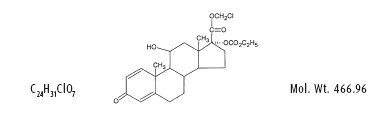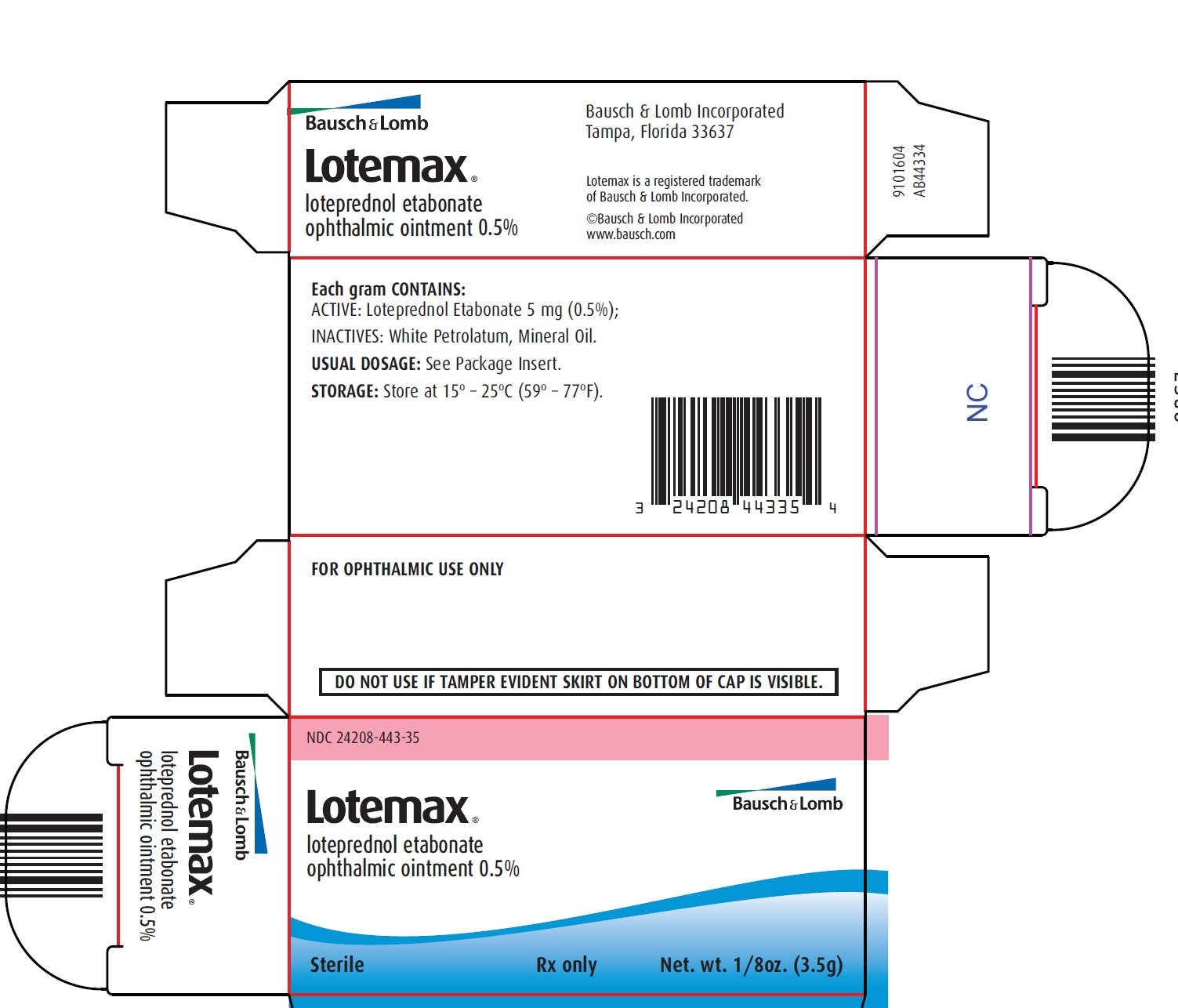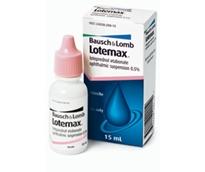Lotemax Eye Ointment: Package Insert / Prescribing Info
Package insert / product label
Generic name: loteprednol etabonate
Dosage form: ophthalmic ointment
Drug class: Ophthalmic steroids
Medically reviewed by Drugs.com. Last updated on Mar 25, 2025.
On This Page
- Indications and Usage
- Dosage and Administration
- Dosage Forms and Strengths
- Contraindications
- Warnings and Precautions
- Adverse Reactions/Side Effects
- Use In Specific Populations
- Description
- Clinical Pharmacology
- Nonclinical Toxicology
- Clinical Studies
- How Supplied/Storage and Handling
- Patient Counseling Information
Highlights of Prescribing Information
Initial U.S. Approval: 1998
Indications and Usage for Lotemax Eye Ointment
LOTEMAX ointment is a corticosteroid indicated for the treatment of post-operative inflammation and pain following ocular surgery. (1)
Lotemax Eye Ointment Dosage and Administration
Apply a small amount (approximately ½ inch ribbon) into the conjunctival sac(s) four times daily beginning 24 hours after surgery and continuing throughout the first 2 weeks of the post-operative period. (2)
Dosage Forms and Strengths
3.5 gram tube filled with loteprednol etabonate ophthalmic ointment, 0.5% (3)
Contraindications
LOTEMAX ointment, as with other ophthalmic corticosteroids, is contraindicated in most viral diseases of the cornea and conjunctiva including epithelial herpes simplex keratitis (dendritic keratitis), vaccinia, and varicella, and also in mycobacterial infection of the eye and fungal diseases of ocular structures. (4)
Warnings and Precautions
- •
- Intraocular pressure (IOP) increase–Prolonged use of corticosteroids may result in glaucoma with damage to the optic nerve, defects in visual acuity and fields of vision. If this product is used for 10 days or longer, IOP should be monitored even though it may be difficult in children and uncooperative patients. (5.1)
- •
- Cataracts–Use of corticosteroids may result in posterior subcapsular cataract formation. (5.2)
- •
- Delayed healing–The use of steroids after cataract surgery may delay healing and increase the incidence of bleb formation. In those diseases causing thinning of the cornea or sclera, perforations have been known to occur with the use of topical steroids. (5.3)
- •
- Bacterial infections–Prolonged use of corticosteroids may suppress the host response and thus increase the hazard of secondary ocular infections. In acute purulent conditions, steroids may mask infection or enhance existing infection. (5.4)
- •
- Viral infections–Employment of a corticosteroid medication in the treatment of patients with a history of herpes simplex requires great caution. Use of ocular steroids may prolong the course and may exacerbate the severity of many viral infections of the eye (including herpes simplex). (5.5)
- •
- Fungal infections–Fungal infections of the cornea are particularly prone to develop coincidentally with long-term local steroid application. Fungus invasion must be considered in any persistent corneal ulceration where a steroid has been used or is in use. (5.6)
Adverse Reactions/Side Effects
The most common ocular adverse event, reported in approximately 25% of subjects in clinical studies, is anterior chamber inflammation. Other common adverse events, with an incidence of 4-5%, are conjunctival hyperemia, corneal edema, and eye pain. (6)
To report SUSPECTED ADVERSE REACTIONS, contact Bausch & Lomb at 1-800-323-0000 or FDA at 1-800-FDA-1088 or www.fda.gov/medwatch
See 17 for PATIENT COUNSELING INFORMATION.
Revised: 10/2014
Full Prescribing Information
1. Indications and Usage for Lotemax Eye Ointment
LOTEMAX® ointment is a corticosteroid indicated for the treatment of post-operative inflammation and pain following ocular surgery.
2. Lotemax Eye Ointment Dosage and Administration
Apply a small amount (approximately ½ inch ribbon) into the conjunctival sac(s) four times daily beginning 24 hours after surgery and continuing throughout the first 2 weeks of the post-operative period.
3. Dosage Forms and Strengths
LOTEMAX is supplied sterile in a 3.5 gram tube filled with loteprednol etabonate ophthalmic ointment, 0.5%.
4. Contraindications
LOTEMAX ointment, as with other ophthalmic corticosteroids, is contraindicated in most viral diseases of the cornea and conjunctiva including epithelial herpes simplex keratitis (dendritic keratitis), vaccinia, and varicella, and also in mycobacterial infection of the eye and fungal diseases of ocular structures.
5. Warnings and Precautions
5.1 Intraocular pressure (IOP) increase
Prolonged use of corticosteroids may result in glaucoma with damage to the optic nerve, defects in visual acuity and fields of vision. If this product is used for 10 days or longer, IOP should be monitored even though it may be difficult in children and uncooperative patients.
5.3 Delayed healing
The use of steroids after cataract surgery may delay healing and increase the incidence of bleb formation. In those diseases causing thinning of the cornea or sclera, perforations have been known to occur with the use of topical steroids.
The initial prescription and renewal of the medication order beyond 14 days should be made by a physician only after examination of the patient with the aid of magnification such as slit lamp biomicroscopy and, where appropriate, fluorescein staining.
5.4 Bacterial infections
Prolonged use of corticosteroids may suppress the host response and thus increase the hazard of secondary ocular infections. In acute purulent conditions, steroids may mask infection or enhance existing infection. If signs and symptoms fail to improve after 2 days, the patient should be re-evaluated.
5.5 Viral infections
Employment of a corticosteroid medication in the treatment of patients with a history of herpes simplex requires great caution. Use of ocular steroids may prolong the course and may exacerbate the severity of many viral infections of the eye (including herpes simplex).
5.6 Fungal infections
Fungal infections of the cornea are particularly prone to develop coincidentally with long-term local steroid application. Fungus invasion must be considered in any persistent corneal ulceration where a steroid has been used or is in use. Fungal culture should be taken when appropriate.
5.7 Contact Lens Wear
Patients should not wear contact lenses during their course of therapy with LOTEMAX ointment.
5.8 Amblyopia
LOTEMAX (loteprednol etabonate ophthalmic ointment), 0.5% should not be used in children following ocular surgery. Its use may interfere with amblyopia treatment by hindering the child’s ability to see out of the operated eye (see Pediatric Use, 8.4).
6. Adverse Reactions/Side Effects
Adverse reactions associated with ophthalmic steroids include elevated intraocular pressure, which may be associated with optic nerve damage, visual acuity and field defects, posterior subcapsular cataract formation, secondary ocular infection from pathogens including herpes simplex, and perforation of the globe where there is thinning of the cornea or sclera.
The most common ocular adverse event reported at approximately 25% in subjects in clinical studies with Lotemax ointment was anterior chamber inflammation. Other common adverse events, with an incidence of 4-5%, were conjunctival hyperemia, corneal edema, and eye pain. Many of these events may have been the consequence of the surgical procedure. The only non-ocular adverse event occurring at ≥ 1% was headache (1.5%).
8. Use In Specific Populations
8.1 Pregnancy
Teratogenic effects: Pregnancy Category C.
Loteprednol etabonate has been shown to be embryotoxic (delayed ossification) and teratogenic (increased incidence of meningocele, abnormal left common carotid artery, and limb flexures) when administered orally to rabbits during organogenesis at a dose of 3 mg/kg/day (150 times the maximum daily clinical dose), a dose which caused no maternal toxicity. The no-observed-effect-level (NOEL) for these effects was 0.5 mg/kg/day (25 times the maximum daily clinical dose). Oral treatment of rats during organogenesis resulted in teratogenicity (absent innominate artery at ≥ 5 mg/kg/day doses, and cleft palate and umbilical hernia at ≥ 50 mg/kg/day) and embryotoxicity (increased post-implantation losses at 100 mg/kg/day and decreased fetal body weight and skeletal ossification with ≥ 50 mg/kg/day). Treatment of rats with 0.5 mg/kg/day (25 times the maximum daily clinical dose) during organogenesis did not result in any reproductive toxicity. Loteprednol etabonate was maternally toxic (significantly reduced body weight gain during treatment) when administered to pregnant rats during organogenesis at doses of ≥ 5 mg/kg/day.
Oral exposure of female rats to 50 mg/kg/day of loteprednol etabonate from the start of the fetal period through the end of lactation, a maternally toxic treatment regimen (significantly decreased body weight gain), gave rise to decreased growth and survival, and retarded development in the offspring during lactation; the NOEL for these effects was 5 mg/kg/day. Loteprednol etabonate had no effect on the duration of gestation or parturition when administered orally to pregnant rats at doses up to 50 mg/kg/day during the fetal period.
LOTEMAX should be used during pregnancy only if the potential benefit justifies the potential risk to the embryo or fetus.
8.3 Nursing Mothers
It is not known whether topical ophthalmic administration of corticosteroids could result in sufficient systemic absorption to produce detectable quantities in human milk. Systemically administered steroids appear in human milk and could suppress growth, interfere with endogenous corticosteroid production, or cause other untoward effects. Caution should be exercised when LOTEMAX ointment is administered to a nursing woman.
8.4 Pediatric Use
Safety and effectiveness in pediatric patients have not been established.
LOTEMAX (loteprednol etabonate ophthalmic ointment) 0.5% should not be used in children following ocular surgery. Its use may interfere with amblyopia treatment by hindering the child’s ability to see out of the operated eye.
11. Lotemax Eye Ointment Description
LOTEMAX (loteprednol etabonate ophthalmic ointment) 0.5% is a sterile, topical corticosteroid for ophthalmic use. Loteprednol etabonate is a white to off-white powder.
Loteprednol etabonate is represented by the following structural formula:
Chemical Name:
chloromethyl 17α-[(ethoxycarbonyl)oxy]-11β-hydroxy-3-oxoandrosta-1,4-diene-17β-carboxylate
Each gram contains:
ACTIVE: Loteprednol Etabonate 5 mg (0.5%);
INACTIVES: Mineral Oil and White Petrolatum.
12. Lotemax Eye Ointment - Clinical Pharmacology
12.1 Mechanism of Action
Corticosteroids inhibit the inflammatory response to a variety of inciting agents and probably delay or slow healing. They inhibit the edema, fibrin deposition, capillary dilation, leukocyte migration, capillary proliferation, fibroblast proliferation, deposition of collagen, and scar formation associated with inflammation. While glucocorticoids are known to bind to and activate the glucocorticoid receptor, the molecular mechanisms involved in glucocorticoid/glucocorticoid receptor-dependent modulation of inflammation are not clearly established. However, corticosteroids are thought to inhibit prostaglandin production through several independent mechanisms.
12.3 Pharmacokinetics
The systemic exposure to loteprednol etabonate following ocular administration of LOTEMAX ointment has not been studied in humans. However, results from a bioavailability study with LOTEMAX suspension in normal volunteers established that plasma concentrations of loteprednol etabonate and Δ¹ cortienic acid etabonate (PJ 91), its primary, inactive metabolite, were below the limit of quantitation (1 ng/mL) at all sampling times. The results were obtained following the ocular administration of one drop in each eye of 0.5% loteprednol etabonate suspension, 8 times daily for 2 days or 4 times daily for 42 days. The maximum systemic exposure to loteprednol following administration of the ointment product dosed four times daily is not expected to exceed exposures attained with LOTEMAX suspension dosed up to two drops four times daily.
13. Nonclinical Toxicology
13.1 Carcinogenesis, Mutagenesis, Impairment of Fertility
Long-term animal studies have not been conducted to evaluate the carcinogenic potential of loteprednol etabonate. Loteprednol etabonate was not genotoxic in vitro in the Ames test, the mouse lymphoma tk assay, or in a chromosome aberration test in human lymphocytes, or in vivo in the single dose mouse micronucleus assay. Treatment of male and female rats with up to 50 mg/kg/day and 25 mg/kg/day of loteprednol etabonate, respectively, (2500 and 1250 times the maximum daily clinical dose, respectively) prior to and during mating did not impair fertility in either gender.
14. Clinical Studies
In two independent, randomized, multicenter, double-masked, parallel-group, vehicle-controlled studies in 805 subjects meeting a protocol-specified threshold amount of anterior chamber inflammation, LOTEMAX ointment was more effective compared to its vehicle for complete resolution of post-operative anterior chamber cell, flare, and pain following cataract surgery. Primary endpoint was complete resolution of anterior chamber cells and flare (cell count of 0 and no flare) and no pain at post-operative day 8. The individual clinical trial results are provided below.
In the 2 studies, Lotemax had statistically significant higher incidence of complete clearing of anterior chamber cells and flare at post-operative day 8 (24-32% vs. 11-14%) and also had a statistically significant higher incidence of subjects that were pain free at post-operative day 8 (73-78% vs. 41-45%).
16. How is Lotemax Eye Ointment supplied
LOTEMAX (loteprednol etabonate ophthalmic ointment), 0.5% is a sterile ointment supplied in a tin tube with a pink polypropylene cap in the following size:
3.5 gram (NDC 24208-443-35)
Do not use if tamper evident skirt is visible on bottom of cap.
Storage: Store between 15°–25°C (59°–77°F).
Rx only.
17. Patient Counseling Information
17.1 Risk of Contamination
Patients should be advised not to touch the eyelid or surrounding areas with the tip of the tube. The cap should remain on the tube when not in use.
Patients should be advised to wash hands prior to using LOTEMAX ointment.
Do not use if tamper evident skirt is visible on bottom of cap.
17.2 Contact Lens Wear
Patients should also be advised not to wear contact lenses during their course of therapy.
17.3 Risk of Secondary Infection
If pain, redness, itching or inflammation becomes aggravated, the patient should be advised to consult a physician.
MANUFACTURER INFORMATION
Bausch & Lomb Incorporated
Tampa, Florida 33637 USA
©Bausch & Lomb Incorporated
Lotemax is a registered trademark of Bausch & Lomb Incorporated
9234801 (flat)
9234901 (folded)
| LOTEMAX
loteprednol etabonate ointment |
||||||||||||||||||||||||||||||
|
||||||||||||||||||||||||||||||
|
||||||||||||||||||||||||||||||
|
||||||||||||||||||||||||||||||
|
||||||||||||||||||||||||||||||
|
||||||||||||||||||||||||||||||
| Labeler - Bausch & Lomb Incorporated (196603781) |
| Establishment | |||
| Name | Address | ID/FEI | Business Operations |
|---|---|---|---|
| Bausch & Lomb Incorporated | 807927397 | MANUFACTURE(24208-443) | |
Frequently asked questions
More about Lotemax (loteprednol ophthalmic)
- Check interactions
- Compare alternatives
- Pricing & coupons
- Reviews (16)
- Drug images
- Side effects
- Dosage information
- During pregnancy
- Generic availability
- Drug class: ophthalmic steroids
- Breastfeeding
- En español



